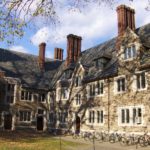What Are the Little Ivies and NESCAC?
What’s Covered:
While most people are familiar with the Ivy League, fewer realize that other athletic conferences also bring together academically prestigious colleges and universities. One such conference, the New England Small College Athletic Conference (NESCAC), includes 11 exceptional liberal arts colleges in the Northeast and offers students both rigorous academics and competitive athletics.
These schools are also part of the “Little Ivies,” a group of challenging liberal arts colleges across the Northeast. Read on to discover what unites the NESCAC schools and Little Ivies—and what makes each one unique.
What Is the NESCAC?
The New England Small College Athletic Conference (NESCAC) is an NCAA Division III athletic conference. While the schools that make up the NESCAC share a common history, selective admissions, and a reputation for academic excellence, the formal criterion for inclusion in the NESCAC is actually sports-related rather than academics-related. This structure, where academically excellent schools come together to form an athletic league, is similar to that of the Ivy League, an NCAA Division I athletic conference.
Because the schools of the NESCAC and the Ivy League are grouped by athletic conference, the most obvious distinction between them is that student-athletes in the Ivy League participate in a Division I league, which necessitates more intense training and competing year-round. Student-athletes attending NESCAC schools, on the other hand, only compete during their sport’s season.
For the student who excels in both academics and athletics, a NESCAC school could be a great fit, as student-athletes can participate in multiple sports while also challenging themselves academically.
Here’s a brief rundown of the 11 NESCAC schools:
|
Institution |
Location |
Acceptance Rate |
|
Amherst, MA |
9% |
|
|
Lewiston, ME |
13% |
|
|
Brunswick, ME |
7% |
|
|
Waterville, ME |
7% |
|
|
New London, CT |
37% |
|
|
Clinton, NY |
14% |
|
|
Middlebury, VT |
11% |
|
|
Hartford, CT |
36% |
|
|
Medford, MA |
11% |
|
|
Middletown, CT |
16% |
|
|
Williamstown, MA |
8% |
1. Amherst College
Location: Amherst, MA
Acceptance Rate: 9%
Middle 50% SAT/ACT: 1500-1560 SAT, 33-35 ACT
Undergraduate Enrollment: 1,914
Amherst College is located in the Connecticut River Valley and is the third-oldest institution of higher education in Massachusetts. From the college town of Amherst, students can easily access Boston and New York via train.
The college is part of the Five College Consortium—along with Hampshire College, Mount Holyoke College, Smith College, and UMass Amherst—which offers students access to courses and resources at four other outstanding institutions. Additionally, Amherst students can exercise independence in their education through the school’s open curriculum.
Learn more about Amherst and see your chances of acceptance.
2. Bates College
Location: Lewiston, ME
Acceptance Rate: 13%
Middle 50% SAT/ACT: 1410-1490 SAT, 30-33 ACT
Undergraduate Enrollment: 1,760
Bates is a prestigious university in Maine, and is known for the close bonds forged between students and the overall friendliness of the student body. Students at Bates are intellectuals and commonly take their academic conversations outside the classroom. The school has a high freshman retention rate, indicating that students are satisfied with their overall academic and social experiences.
Learn more about Bates and see your chances of acceptance.
3. Bowdoin College
Location: Brunswick, ME
Acceptance Rate: 7%
Middle 50% SAT/ACT: 1470-1540 SAT, 31-35 ACT
Undergraduate Enrollment: 1,881
Bowdoin—home of the Polar Bears—is a private liberal arts college in Maine, and is consistently ranked as one of the top liberal arts colleges in the nation. At Bowdoin, there is a strong sense of community among students, staff, and professors.
The school was chartered in 1794 with the foundational value of pursuing “The Common Good.” This focus has not wavered, and students are encouraged by their professors and peers to use their talents in ways that benefit their community.
Learn more about Bowdoin and see your chances of acceptance.
4. Colby College
Location: Waterville, ME
Acceptance Rate: 7%
Middle 50% SAT/ACT: 1440-1550 SAT, 32-34 ACT
Undergraduate Enrollment: 2,284
Colby College boasts strong academics and a small, close-knit community in the picturesque state of Maine. Colby was the first college to implement the unique 4-1-4 academic calendar, where students take four classes in the fall and four classes in the spring, as well as an additional one class (taken pass/fail) during January.
Additionally, Colby is known for the “Colby Commitment,” which earns it a place on CollegeVine’s list of schools that meet 100% of students’ demonstrated financial need without loans.
Learn more about Colby and see your chances of acceptance.
5. Connecticut College
Location: New London, CT
Acceptance Rate: 37%
Middle 50% SAT/ACT: 1160-1400 SAT, 28-32 ACT
Undergraduate Enrollment: 1,990
Connecticut College is a liberal arts institution that focuses on interdisciplinary education. The school offers small classes and uses a self-scheduled exam system, trusting students to abide by the school’s Honor Code. Professors are generally thought of as approachable and, due to the small student population, are familiar with their students. Dorms are central to social life at Connecticut College, allowing students to forge meaningful relationships with their peers.
Learn more about Connecticut College and see your chances of acceptance.
6. Hamilton College
Location: Clinton, NY
Acceptance Rate: 14%
Middle 50% SAT/ACT: 1460-1530 SAT, 33-35 ACT
Undergraduate Enrollment: 2,037
Hamilton is an academically rigorous school with an open curriculum. The students, staff, and faculty at Hamilton are generally thought of as kind and accommodating. Additionally, the faculty and the college’s curriculum emphasize the value of critical conversations, meaningful discussions, and excellent writing skills.
Hamilton College is characterized by its numerous traditions, which include Class & Charter Day—afternoon classes are canceled on the last day of the semester so students can celebrate their successes throughout the year.
Learn more about Hamilton and see your chances of acceptance.
7. Middlebury College
Location: Middlebury, VT
Acceptance Rate: 11%
Middle 50% SAT/ACT: 1450-1530 SAT, 33-35 ACT
Undergraduate Enrollment: 2,760
Middlebury was founded in 1800, making it the oldest operating college in Vermont. The school’s beautiful campus is a popular tourist destination and is considered one of the nation’s most picturesque college campuses, especially in the fall.
Middlebury is an innovative school with a global/international focus—it’s known for its emphasis on language instruction, travel programs, and experiential learning. Students at Middlebury have a reputation for being cooperative and friendly, constantly striving to better themselves and help others.
Learn more about Middlebury and see your chances of acceptance.
8. Trinity College
Location: Hartford, CT
Acceptance Rate: 36%
Middle 50% SAT/ACT: 1350-1440 SAT, 30-33 ACT
Undergraduate Enrollment: 2,167
Trinity is distinct from many other small liberal arts colleges due to its urban location in Hartford, Connecticut. Just outside of campus, students have access to restaurants, shops, and vibrant nightlife.
One unique aspect of Trinity is the interwoven academic and social lives of students. Incoming freshmen are required to take a first-year seminar on a topic of their choice, and then they are grouped into residence halls based on their different seminars. This arrangement allows students to get to know their peers and form relationships with those who share similar interests.
Learn more about Trinity and see your chances of acceptance.
9. Tufts University
Location: Medford, MA
Acceptance Rate: 11%
Middle 50% SAT/ACT: 1480-1540 SAT, 33-35 ACT
Undergraduate Enrollment: 7,126
Tufts is a research university with an outstanding liberal arts program. It is distinguished from many other liberal arts schools through its pre-med program, which is known for its academic rigor and its renowned professors. Overall, the university is known for providing the personalized attention of a liberal arts college and the resources of a research institution. Many students describe Tufts as not too big, but not too small, and not too urban, but not too suburban.
Learn more about Tufts and see your chances of acceptance.
10. Wesleyan University
Location: Middletown, CT
Acceptance Rate: 16%
Middle 50% SAT/ACT: 1300-1500 SAT, 31-34 ACT
Undergraduate Enrollment: 3,805
Wesleyan is known for its academic excellence, as well as its open-minded and creative student body. The school’s administration works hard to foster independence in its students, as seen through the school’s commitment to an open curriculum. Through the open curriculum, students can take courses in a diverse range of subjects and explore their varied interests. Wesleyan rewards its students for academic curiosity, making growth and exploration a central focus of campus life.
Learn more about Wesleyan and see your chances of acceptance.
11. Williams College
Location: Williamstown, MA
Acceptance Rate: 8%
Middle 50% SAT/ACT: 1500-1560 SAT, 34-35 ACT
Undergraduate Enrollment: 2,101
Williams College—originally founded as a men’s college, but coeducational since the 1960s—is a private liberal arts school that boasts small class sizes and individualized attention from professors. The school operates on a 4-1-4 schedule pioneered by Colby College.
Williams is also known for the opportunity its students have to participate in tutorials—two-person classes that help students deepen their understanding of a particular niche subject. Williams meets 100% of a student’s demonstrated need for all four undergraduate years.
Learn more about Williams and see your chances of acceptance.
What Are the Little Ivies?
When cultural perceptions and academic prestige are taken into account, seven schools join the eleven NESCAC schools to form the “Little Ivies.” These additional highly competitive liberal arts schools are also located in the Northeast, but are outside of New England (and thus, outside of the New England Small Colleges Athletic Conference).
Despite sharing many characteristics with the Ivy League—most notably being historic, academically competitive, and highly regarded—there are numerous ways the Little Ivies distinguish themselves from the Ivies. The Little Ivies are typically small (the one exception being Tufts University, whose total enrollment has grown to more than 13,000 students), rural, and focused on liberal arts.
These smaller populations and campuses generally facilitate productive and consistent relationships between professors and students, preventing students from falling through the cracks. If you are looking for a close-knit community of academically motivated peers, these other Little Ivies might be worth checking out!
Here is your rundown of the additional seven schools that complete the Little Ivies:
|
Institution |
Location |
Acceptance Rate |
|
Lewisburg, PA |
29% |
|
|
Hamilton, NY |
14% |
|
|
Haverford, PA |
12% |
|
|
Easton, PA |
31% |
|
|
Swarthmore, PA |
7% |
|
|
Schenectady, NY |
44% |
|
|
Poughkeepsie, NY |
19% |
1. Bucknell University
Location: Lewisburg, PA
Acceptance Rate: 29%
Middle 50% SAT/ACT: 1170-1380 SAT, 26-32 ACT
Undergraduate Enrollment: 3,969
Bucknell is an innovative liberal arts college in central Pennsylvania. The University simultaneously excels in technical fields and the humanities. Incoming students can live in themed residential colleges that are aligned with one of their first-semester classes. This allows students to live and learn alongside students who share their interests.
One unique aspect of Bucknell is the popularity of Greek life there. The Greek system has a strong influence on campus culture, with 49% of students participating.
Learn more about Bucknell and see your chances of acceptance.
2. Colgate University
Location: Hamilton, NY
Acceptance Rate: 14%
Middle 50% SAT/ACT: 1450-1530 SAT, 33-34 ACT
Undergraduate Enrollment: 3,193
Colgate students are committed to their interdisciplinary studies. Students are not required to declare a major until the end of their sophomore year, and they find many opportunities for exploration through the school’s ample course offerings. Additionally, students can foster intimate relationships with their professors and peers. These relationships often help students navigate their major choices and career goals.
Learn more about Colgate and see your chances of acceptance.
3. Haverford College
Location: Haverford, PA
Acceptance Rate: 12%
Middle 50% SAT/ACT: 1470-1540 SAT, 33-35 ACT
Undergraduate Enrollment: 1,430
Haverford is a small liberal arts school that participates in the Tri-College and Quaker Consortiums. Through the Quaker Consortium, Haverford students can take classes at Swarthmore College, Bryn Mawr College, and the University of Pennsylvania. Haverford and Bryn Mawr have a particularly strong relationship as they share many resources (like a newspaper and a radio station).
At Haverford, students benefit from a 9:1 student-to-faculty ratio. Roughly a third of Haverford’s faculty even lives on campus. The school places a strong emphasis on its Honor Code and is known for its dedication to meeting 100% of accepted students’ demonstrated financial need.
Learn more about Haverford and see your chances of acceptance.
4. Lafayette College
Location: Easton, PA
Acceptance Rate: 31%
Middle 50% SAT/ACT: 1370-1490 SAT, 31-33 ACT
Undergraduate Enrollment: 2,775
Lafayette College offers an outstanding liberal arts education to students and also boasts particularly prestigious engineering and science programs. Due to the school’s prime location, students have access to major metropolitan areas like New York City and Philadelphia.
Additionally, Lafayette students are connected to an extensive alumni network that often leads students to job and research opportunities. The school has a very high medical school acceptance rate and a high freshman retention rate, indicative of student satisfaction.
Learn more about Lafayette College and see your chances of acceptance.
5. Swarthmore College
Location: Swarthmore, PA
Acceptance Rate: 7%
Middle 50% SAT/ACT: 1500-1550 SAT, 31-35 ACT
Undergraduate Enrollment: 1,623
Swarthmore was originally founded by the Quakers but lost its religious affiliation over a century ago. The College is known for its quirky and engaged student population. Students at Swarthmore have the unique opportunity to design their own majors and course plans if they so choose. Like Haverford, Swarthmore is part of the Tri-College and Quaker Consortiums, which affords its students additional academic opportunities.
Learn more about Swarthmore and see your chances of acceptance.
6. Union College
Location: Schenectady, NY
Acceptance Rate: 44%
Middle 50% SAT/ACT: 1310-1480 SAT, 29-33 ACT
Undergraduate Enrollment: 2,065
Union College was initially an all-male school, but it opened its doors to women in 1970. The school offers a comprehensive liberal arts education through more than 20 academic departments.
Union College is also ABET-accredited to offer degrees in engineering fields, which distinguishes it from other colleges focused on the humanities. Studying abroad is very common amongst Union undergraduates, with around 60% of students studying abroad during their four years.
Learn more about Union College and see your chances of acceptance.
7. Vassar College
Location: Poughkeepsie, NY
Acceptance Rate: 19%
Middle 50% SAT/ACT: 1460-1520 SAT, 33-35 ACT
Undergraduate Enrollment: 2,462
Vassar was founded as one of the Seven Sisters colleges—a group of historically all-women colleges in the Northeast. In 1969, however, the college began accepting male applicants—men now make up about 40% of the school’s small student body. Vassar boasts an open curriculum, meaning that students have very few requirements outside of their major and are given lots of freedom in their education.
Learn more about Vassar and see your chances of acceptance.
What Are Your Chances of Acceptance?
Many students are drawn to the Little Ivies because they are seen as an easier path to being accepted into a top school. Generally, the test scores of students at the Little Ivies are lower than those required by the Ivy League schools. The average SAT score of incoming freshmen at Ivy League schools is around 40 points higher than that of freshmen entering the top nine Liberal Arts Colleges.
When considering selectivity, it’s important to remember to create a balanced college list. Students should generally apply to 8-10 schools, with about 25% being safety schools, 40% being target schools, and 35% being reach schools. These categories—safety, target, and reach—are determined by your chances of acceptance at the schools you are applying to.
Your personal chances of acceptance at the Little Ivies may differ from the average acceptance rate. We’ve made it easy to figure out which schools fall into which categories with our free chancing engine. By taking into account your grades, test scores, and extracurriculars, we’ll estimate your odds of acceptance at different schools and give you tips on improving your profile.



